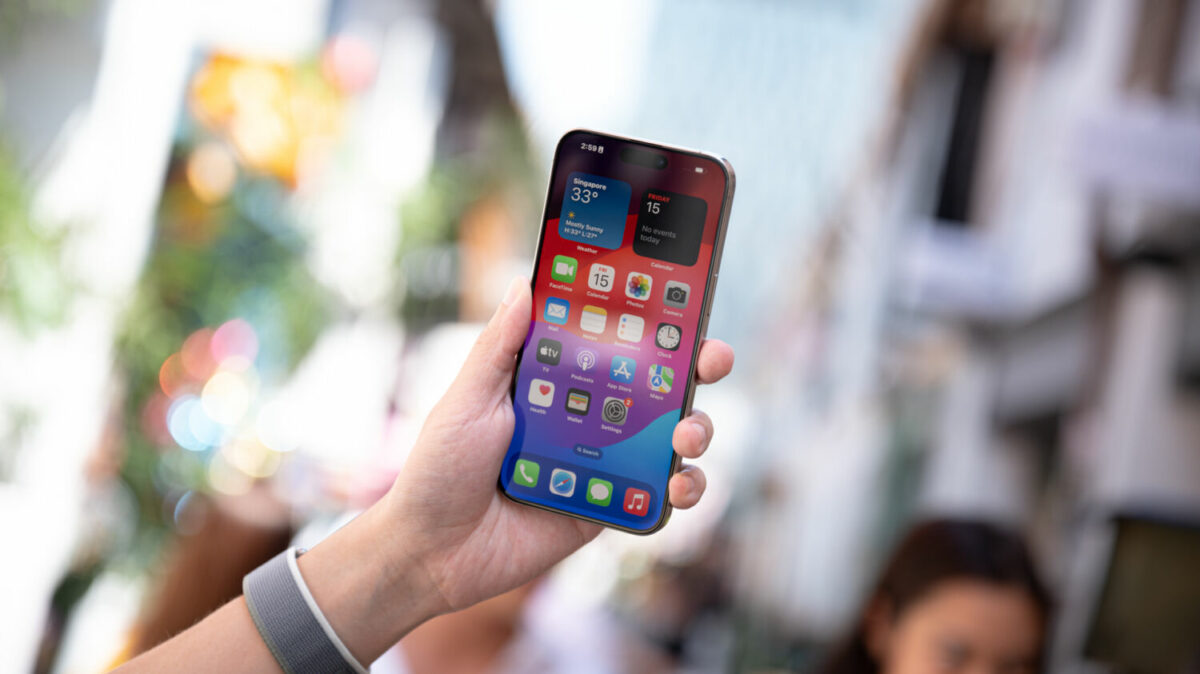It took them years of trying, but Apple has finally capitulated to a mix of legislative and consumer demands, to give us an iPhone with a universal connector, in this case, USB-C over the previous Lightning connector.
It might seem contrived to focus on a simple change in cable and connector to kick off a review, but this has been a long time coming, ever since the 30-Pin dock connector on the first iPhone established Apple’s preference on using its own proprietary connectors. In the last few years though, the iPad and MacBooks have adopted USB-C so it was only a matter of time before the iPhone made the change as well, and this marks a great sign that Apple is slowly but finally opening up its walled garden.

And that makes the iPhone 15 series one of the biggest smartphone devices to come out of the American tech giant. Those of you entrenched into the Apple ecosystem won’t have to pack a different cable just to charge your phone, and the same cable can be used on your MacBook, iPad and phone, which will be a boon for families traveling. Apple also announced an updated AirPods Pro with USB-C to accompany their latest phone, one that is capable of being charged by Apple devices when connected with the cable, which in itself is a clear sign that Lightning isn’t striking here ever again.
As with before, Apple announced four versions of the iPhone 15. The iPhone 15 and iPhone 15 Plus differ in screen size, 6.1-inch and 6.7-inch respectively, and are powered by last year’s A16 Bionic chip with two rear cameras. Both the higher-end Pro models come in the same two size options, are powered by the latest A17 Pro chip and driven by three rear cameras.

Of course, nothing is ever that simple with Apple, and neither is its USB-C rollout. There are different USB-C charging cables that charge your device and support data transfer, and the iPhone 15 and iPhone 15 Plus offer USB 2 speeds. The Pro models support fast USB 3.2 Gen 2 speeds, of up to 10Gbit per second, but the catch is that you need a USB 3 cable that allows that, and not surprisingly, the USB-C cable packed with all iPhone 15 models is only rated for USB 2 speeds.

Apple has been encouraging users to shoot video on the top-tier iPhone for some time now and with the improved USB speeds, it has finally become a reality. Amateur filmmakers can consider using the device to record ProRes 4K 60FPS footage directly into an external SSD opening up a new world of possibilities of content creation starting with a mobile phone.
But more than a cable change, the iPhone has always been about offering the tried and tested, with something slightly new added into the mix, and the iPhone 15 Pro Max and iPhone 15 Pro offers just that, tapping on an already classic design with new built materials and processor.

Instead of an aluminium frame that has defined the curved edge design of the last few models, Apple has opted to use brush-finished titanium for this year’s Pro models, providing a more textured finish to the final design. On the surface, the brush effect prevents fingerprints from sticking to the outer chassis, but they also provide a much better grip. Anyone with clammy hands, or who likes using one hand to hold their devices would appreciate the better grip that the brushed effect provides.
While the looks and feels remain similar, the changes where it matters are in the hardware. The A17 Pro chip drops the Bionic nomenclature, which has been the branding for Apple’s system on a chip for the last seven years. The 64-bit six-core CPU has two high-performance cores running at 3.78 GHz alongside four energy-efficient cores. Apple touts a 10 per cent increase in performance and on the Geekbench 6 performance measurement test, the iPhone 15 Pro Max scored 2,905 on the single core and 7,232 on the multicore CPU benchmark, and 27,196 on the GPU benchmark. That’s higher than the 2,552 and 6,683 on the single and multicore CPU benchmark, and 22,676 on the GPU benchmark on the iPhone 14 Pro Max.
On the Antutu benchmark, the iPhone 15 Pro Max generated a CPU performance score of 383,341 and GPU performance of 489,721, compared to the iPhone 14 Pro Max’s 380,209 for CPU, and 465, 239 for GPU on the iPhone 14 Pro Max.
These figures probably don’t mean much to the general public, aside from the fact that they are superior to last year’s model but the devil is in the details and we had the opportunity to test the upcoming Resident Evil Village via TestFlight on the new device. Granted, the performance of a new game via a developer’s portal is not playing the actual game, but Resident Evil Village started out as a console game in 2021, and it’s appearance on iOS marks the first time that the game has been primed for a mobile device, and having played the game on consoles and the MacBook, we’re aware of what the game is capable of in terms of sharp graphics and smooth gameplay, and the experience left us impressed.
Resident Evil Village runs beautifully on the iPhone 15 Pro Max. Thanks to its powerful A17 Pro chip, the game runs at a smooth 30 fps and pretty much looks on par with what we have played on the PlayStation 5 (PS5) in 2021. The textures look great, and controls are snappy, even when connecting our PS5 controller to the iPhone via Bluetooth. Check out our gameplay video to see it for yourself!

In many ways, Apple has never been known for its gaming hardware offerings, but to have a new chip on its latest phone run one of the more graphically intensive games in the market speaks volumes of what the company has in store. The game itself was designed for a large screen, so seeing it on the 6.7-inch display will take some adjustments, but the scompatibility with a PlayStation 5 controller means your phone is now effectively a game console capable capable of much more.
Users will also appreciate the audio from the game through the phone’s speaker. It’s not the haunting silence that permeates much of the game, but the sense that there’s enough audio ambience to indicate that there’s something there, just around the corner that you might be hearing.

But for those who don’t feel the need to play games, or could care less about a change in cable connector, the new Pro models offer an updated camera system. Previously, only the iPhone 14 Pro Max came with a 48MP camera but this year, every iPhone 15 model comes with a 48MP camera. The Pro models use three cameras and only a slight difference separates the Pro and Pro Max. There’s the main 48MP camera with ƒ/1.78 aperture, but uses 24MP as the default image quality, and users can opt for focal lengths of 24mm, 28mm, and 35mm.

The Ultra Wide is a 12MP with 13mm focal length, ƒ/2.2 aperture, and a 120-degree field of view, while the 12MP Telephoto offers a 48mm focal length, at ƒ/1.78 aperture.



Overall, the Pro Max offers up to 5x Telephoto zoom and 25x digital zoom, while the Pro has 3x Telephoto and 15x digital zoom. Apple says that’s basically seven camera lens in one device, which breaks down to a macro mode, ultra wide, then 48MP at 24mm, 28mm, 35mm and 48mm, and 5x telephoto, which offers what Apple terms a ‘tetraprism’ focal length of 120mm.







The main difference is not so much with the details, but the colours in the photos have been tweaked. In recent years, oversaturation of colours has been described as rich and vibrant, but its software augmentation makes images pop with colours. Apple hasn’t done it as much though it was present on the iPhone 14 Pro Max and there’s even less now, as colours seem more true to life than artificially enhanced. There’s a certain natural vibrance to photos taken with the iPhone 15 Pro Max, and once you rewire your expectations to recognise that overly bright colours are not natural, you can appreciate the way things are supposed to look.




Apple’s Portrait Mode, which has been popular is taking detailed photos of individuals and subjects/objects has also received a boost, with quick Portrait Mode when using the main camera. This allows you to snap a portrait photo directly in the camera by tapping on the f-stop icon on the screen when the software recognises that the composition allows for a portrait mode. This effectively blurs out the background and focused on the individual or subject in the centre of the shot.

Now, you can also alter the focus of the photo taken in Portrait Mode. It’s a feature added to the new iOS 17, where you can then change the depth of field in the image, instead of having it baked in at the time of the shot. Say you took a photo of a person and a pet, or of two people, and want to change it such that one of the two is more in focus – now you can. In fact, you can now go to Portraits taken on your iPhone 14 Pro Max, and do the same.

The last big change that will change the way you use your device is the new Action button, which replaces the Ring/Silent button. Like on the Watch Ultra, the dedicated button can be used to trigger one action of your choice, instead of one use that Apple dictates. If you don’t do anything, pressing on it will switch between Ring or Silent mode, but you can now opt for the button to turn on Voice Memo or the torch. You can also use it to turn on the camera, and not just any camera mode, but to turn on the front camera for selfie taking, portrait mode, or to take videos.
Now, you can still silence your phone by swiping down on the screen to get to the menu, and use it to all turn on your torch, but the action button provides you with slightly more control over your device, especially if you love to use the camera, but want something more than just turn on the same camera mode each time.

The iPhone 15 series is greater than the sum of all the improvements Apple has added, and the Pro Max model continues to push for upgrades and offers improvements where it matters. If you want a foldable screen or a camera that dials up the colours in an unnatural way, this device is not for you. For everyone else, the iPhone 15 Pro Max delivers on a great set of upgrades to a device that only needs minor improvements to begin with.
GEEK REVIEW SCORE
Summary
Will all these small changes prompt you to upgrade your device? Few electronics in the world offer a huge change that alters human expectations and behaviour, and collectively, there is enough on the iPhone 15 Pro Max to warrant an upgrade if you’re on an earlier model.
Overall
9.1/10
-
Aesthetics - 9/10
9/10
-
Build Quality - 9/10
9/10
-
Performance - 9.5/10
9.5/10
-
Value - 8.5/10
8.5/10
-
Geek Satisfaction - 9.5/10
9.5/10














